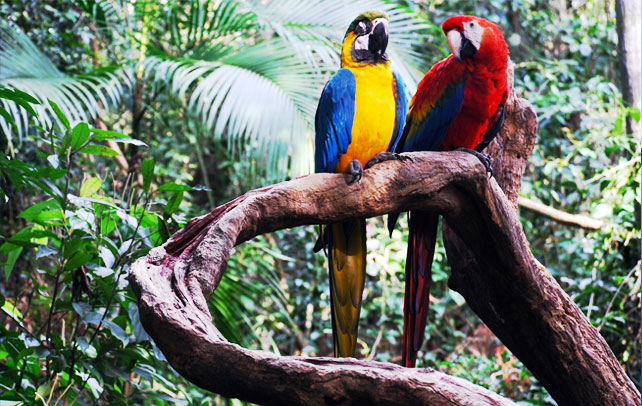Interesting Information On Amazon’s Rainforests

Dense rainforest, indigenous tribes, amazing wildlife — Amazon Rainforest is everything you would imagine it to be! Twice the size of India, this most mesmerizing part of the planet teems with wildlife of rare species, deep lushes, impenetrable jungles, and indigenous cultures and languages. Hotbed of a dizzying array of flora and fauna, Amazon Rainforests have rightly reserved for themselves a fascinating place in every traveler’s wish list. After all what can beat the thrill of canoeing down a swampy forest, waking up to the cries of thousand of forest birds or getting goose bumps at the shrieks of howler monkeys. The massive, unrelenting river cutting right through the heart of this impregnable rainforest further heightens the attraction of this place. For years, man has tried to uncover everything about this baffling forest and have surfaced with many interesting studies. Explore this write-up to know many such interesting facts about Amazon Rainforest.
Interesting Facts About Amazon’s Rainforests
- Amazon Rainforests also referred to as Amazonia, are considered to be the world’s greatest natural resource available, and cover more than half of Brazil.
- This rainforests, which derive their name from the Amazon River, cover about 2.5 million square miles and are the largest tropical forest in the world.
- Also known as the ‘lung of the planet’, as they account to 20% of the world oxygen, these rainforests are more than 55 million years old.
- When taking their size into consideration, they are 9 times the size of Texas with over 40,000 species of the plant, 500 varieties of mammals , 300 species of the reptiles and 1800 species of butterflies.
- The Amazonia is known to be the largest river system of the world. Each time it rains in the river basin, the water drains into the Amazon rainforest and also in to the Amazon River.
- The birds belonging to the Amazon Rainforests are about one third of the world’s bird species, toucan being the most popular icon.
- These amazing rainforests cover up to 2.5 million square miles including nine South America countries: Columbia, Brazil, Peru, Venezuela, Bolivia, Guyana, French Guiana, Ecuador and Suriname, which is almost two thirds of the continent of South America.
- It is indeed a disappointment that every second, about one and one half acres of the rainforests are being lost due to tragic effects of the developing and the industrial countries.
- It is an astonishing fact that the depth of the Amazon Rainforests is such that they consist of nearly fifty Amazon tribes who might have never had any contacts with the outside world ever.
- The Amazon Rainforests are home to about 2, 50,000 Amazon natives that comprise of 215 ethnic groups belonging to people of 170 different languages.
- Amazonia or Amazon rainforests receive approximately 9 feet of rain every year and a fifty percent of it is returned back to the atmosphere through the foliage of trees. Amazing indeed!
- Amazon Rainforesta serve as the drainage basin for the Amazon River and also it’s accompanying tributaries.
- Much of the water of the Amazon’s River comes from the annual snow melt occurring high in the Peruvian Andes. During the times from June to October, one may observe a rise in the water level by up to 30 to 45 feet high.
- The world’s largest fish ‘Pirarucu’ that can grow up to 2.5m long and weigh as much as 250 kg is exclusively found in the Amazon rainforests.
- The fish species found in a single pond of the Amazon is comparatively higher than the number of fishes found in the European river altogether.
- Protection of the Amazon rainforests remains a major issue. However, the rate of deforestation has reduced greatly as the area preserved as conserved land has increased over the last 10 years.
- One may find dangerous creatures in the Amazon rainforests like the jaguar, the anaconda and the cougar.
- Amazon rainforests comprise of four layers or rather communities, with each layer consisting of unique plants, animals and ecosystems.
- About five centuries ago, there were about ten million Indians surviving in the rainforests. Today, the number has gone down and can be accounted to less than 20,000.
- One would find many of the endangered species in these forests, such as the hyacinth macaw, golden lion tamarin, the three toed-sloth followed by many more.









